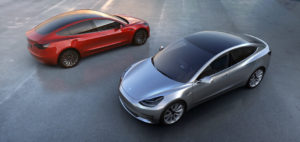Tipping Points and Tesla’s battery dilemma

Tesla Model 3 Electric Vehicle. Photo courtesy Tesla
by Alf Stewart

Tony Seba’s excellent You Tube video, Clean Disruption – Why Energy & Transportation will be obsolete by 2030 – (Oslo, March 2016), covers the concept of tipping points and expands on the concept of our society being on the cusp of a revolution in energy and transportation. It explains that new developments in solar panels, lithium ion batteries, electric cars and autonomous driving are simultaneously converging to create a shift away from oil and towards electricity to power self-driving cars, charged on smart grids, using power from solar renewable energy. Resource World readers, however, are mostly interested in any new opportunities in resource stocks stimulated by this shift.
At the centre of this are Elon Musk and his revolutionary Tesla cars, Powerwall batteries, and solar panels. Musk has disrupted the automobile industry by launching electric cars with performance characteristics so good that they broke Consumer Reports reporting scale for cars by scoring a perfect 100. Tesla Inc. [TSLA-NASDAQ] did this by delivering incredible performance at the same time as delivering unbelievable economy, handling, comfort and interior space.
Musk’s Tesla is now ramping up its Nevada-based Gigafactory to produce batteries, in joint venture with Panasonic, to power its mass market Model 3. It is reported that this factory will produce more lithium ion batteries than all the other battery plants in the world at this point in time. We have been researching the implications of this massive development on the inputs to battery manufacture for resource stocks.
Will it impact oil prices?
Not much in the near term. The global market for electric cars is only 1% of total vehicle sales so even dramatic growth will not change oil demand in the near term.
What about lithium?
Lithium is just the butter on the bread of the lithium ion battery sandwich with the lithium ions shuttling back and forth between the anode and the cathode. Lithium is not the most expensive part of the battery or even the largest component in the battery. Moreover, though there may be some bottlenecks in the supply of high spec pure lithium, there are abundant lithium resources around the world.
What other materials will be most affected? There will be increased demand for graphite, cobalt and nickel.
Can Tesla possibly change the automobile industry in a disruptive way?
Yes, if Tesla can drive the cost of batteries down to about $125 per kilowatt hour of capacity, then according to the US Department of Energy, electric cars could be more economic than ICE cars (internal combustion engine). General Motors recently announced that the battery pack in its electric car, the Chevy Bolt costs $145 per kilowatt hour of capacity as supplied by LG Chem of Korea. So we are nearing the threshold of economic viability for mainstream electric cars if prices continue to trend lower.
There are other barriers to electric car adoption such as charging time, range, convenient charging stations and degradation but let us focus on the raw material inputs.
We have looked at lithium, graphite and manganese and don’t think that these will be obstacles to Elon Musk’s desire for widespread adoption of electric cars, but we think that cobalt is a conundrum.
Why?
Because cobalt is a by-product of nickel and copper mining, it is not a primary product and supply will not respond to increasing demand in an elastic way.
Cobalt is primarily sourced from the Democratic Republic of Congo. This is a politically unstable, conflict laden country that is not a reliable source for a critically important metal. Cobalt produced from the Democratic Republic of Congo includes artisanal mines which are environmentally toxic and unfortunately exploit child labour. There are large cobalt deposits in laterites in Australia and other tropical countries but these are also quite environmentally questionable.
A Tesla Model S contains 15 kilograms of cobalt. I estimate the Model 3 will contain 10 kilograms of cobalt since its battery is smaller, but Tesla has received pre-orders for 400,000 of these. So this will combine with Model S cars, BMW I3’s, Nissan Leafs, Chevy Bolts and VW e-Golfs to generate incremental demand for at least one million kilograms of cobalt per year. That is quite a bit.
Cobalt markets are in a deficit, prices have doubled and the rumblings from the Congo are not good.
So Tesla’s conundrum is: Where can it find an environmentally friendly, large resource of cobalt from a reliable supplier? Anyone know where we can find a large resource that could supply about one thou-sand tonnes of cobalt a year? Anyone? I don’t know of any such resource person-ally, but I do predict an emerging interest in finding such a resource in the next few years.
Alfred Stewart is a financial advisor with Raymond James Ltd. Information provided is not a solicitation and although obtained from sources considered reliable, is not guaranteed. The view and opinions contained in the article are those of Alfred Stewart, not Raymond James Ltd. Raymond James Ltd., member of Canadian Investor Protection Fund.
